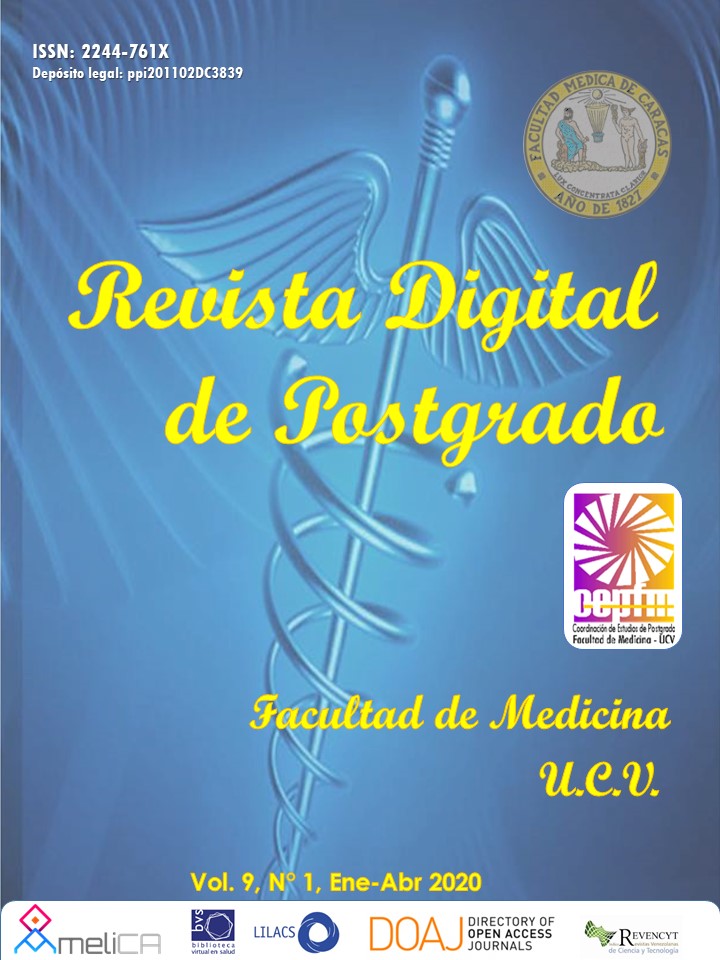Type 2 diabetes mellitus: lens densitometric changes
Keywords:
Diabetes Mellitus, cataract, rotational scheimpflug cameraAbstract
Introduction: Diabetes mellitus is responsible for one fifth of all cataracts, the scheimpflug rotary chamber system allows to study in depth the first changes in the density of these lenses, establishing densitometric values in patients with Type 2 Diabetes Mellitus, with good visual acuity without diabetic retinopathy, and compare these values with a control group without the disease, from June 2017 to March 2018. Methods: a comparative, exploratory and prospective study was carried out, the population and sample was composed of patients who attended the ophthalmological consultation of the Domingo Luciani Hospital. Results: all densitometric values were higher in diabetic patients than in normal patients. The greatest difference occurs in the nucleus values, followed by the anterior capsule approaching the statistical significance (p = 0.02) and (p = 0.01) respectively. 75% of diabetic patients presented significant changes in densitometry of the anterior capsule and 40% in the nucleus. Conclusions: the anterior capsule in diabetic patients with younger age (50 to 60 years) presented higher values of densitometry compared to non-diabetics. In the groups of 61 to 70 and 71 to 80 the values were lower; We conclude that the early changes in the anterior capsule are due to diabetes. As for the nucleus, a progressive increase in density was observed in the control group as the age increased, but when the diabetes factor was added, the values increased markedly, thus accentuating the evolution of the senile cataract. Diabetes precociously alters the density of the anterior capsule and nucleus.Downloads
References
American Diabetes Association. Executive Summary: Standards of Medical Care in Diabetes 2014. Diabetes Care. 2013; 37 (Suppl 1): S5-S13
Beneyto P, Ibáñez M, Leal M, García A, Cabezas M. Medida de la densidad del cristalino con cámara de Scheimpflug en pacientes diabéticos tipo II. Arch Soc Esp Oftalmol. 2007; 82 (3): 141-146
García E, García Robles E. Catarata: una complicación precoz olvidada de la diabetes en la infancia y adolescencia. Endocrinología, Diabetes y Nutrición. 2017;64 (1):58-59
Lima V, Ríos C. Opacidad de cristalino en diabéticos. Prevalencia y asociación con deficiencia visual y retinopatía. Cirugía y Cirujanos, [En línea] 2004; (3):171-175 [Consulta en marzo 2017] Disponible en: http://www.medigraphic.com/pdfs/circir/cc-2004/cc043c
Díaz W, Alarcón O. Cambios en el contenido de glicoproteinas en las cataratas diabéticas. Rev Ven Oftalmol. 2012; (58): 74-80
Bernal-Reyes N, Hormigó-Puertas I, Arias-Díaz, A. Correlación de la densidad del cristalino medida por imágenes de Scheimpflug y parámetros facodinámicos en la optimización de la facoemulsificación. Rev Mex Oftalmol. [En línea] 2017;88(1):32-38.[Consultado en abril 2017] Disponible en: http://www.elsevier.es/es-revista-revista-mexicana-oftalmologia-321-articulo-correlacion-densidad-del-cristalino-medida 0187451914000171#elsevierItemBibliografias
Struck, H, Heider, Lautenschläger. Is diabetes in the elderly patient a risk factor for cataracts? 2001; 98 (7): 952. Pubmed PMID: 11490749
Suárez B, Llull M, Curbelo M, Díaz A, Martínez A. Presencia de afecciones oftalmológicas en pacientes con diabetes mellitus tipo 2. 2011; 9(6): 546-551
American Diabetes Association. Diagnóstico y clasificación de la diabetes mellitus (I). Diabetes Care. [En línea] 2012; 35(1) [Consulta en marzo 2017] Disponible en: http://www.intramed.net/userfiles/2012/file/guias_diabetes1
How to Cite
Issue
Section
License
Usted es libre de:
- Compartir — copiar y redistribuir el material en cualquier medio o formato
- Adaptar — remezclar, transformar y construir a partir del material
- para cualquier propósito, incluso comercialmente.
Bajo los siguientes términos:
-
Atribución — Usted debe dar crédito de manera adecuada, brindar un enlace a la licencia, e indicar si se han realizado cambios. Puede hacerlo en cualquier forma razonable, pero no de forma tal que sugiera que usted o su uso tienen el apoyo de la licenciante.
- No hay restricciones adicionales — No puede aplicar términos legales ni medidas tecnológicas que restrinjan legalmente a otras a hacer cualquier uso permitido por la licencia.











